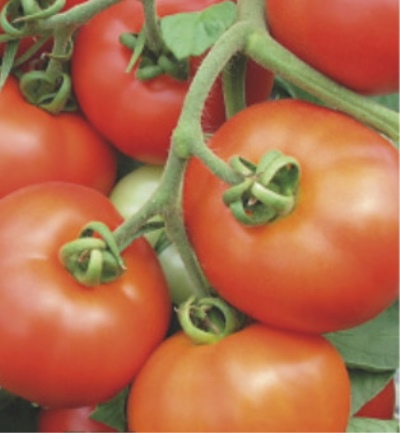
- Authors: Myazina L.A.
- Year of approval: 2008
- Category: hybrid
- Growth type: determinant
- Appointment: fresh consumption
- Ripening period: early
- Ripening time, days: 85-90
- Growing conditions: for open ground, for film greenhouses
- Marketability: Yes
- Transportability: Yes
Tomato varieties, suitable for almost any region of Russia, are in great demand. But only with proper handling of them can you achieve a pleasant result. And Katrina is no exception to this rule.
Breeding history
The plant was created in the 2000s. The development was supervised by the breeder Myazina L.A. The official approval for growing crops in private farms was given in 2008. Then it was entered in the national register.
Description of the variety
Katrina is classified as a determinant hybrid; the crop develops on simple inflorescences and articulated stalks. It is recommended to grow it in open gardens. There is also the possibility of growing under plastic wrap. The height of the bushes varies greatly (from 0.6 to 1.2 m). There are relatively few foliage; medium-sized green leaves develop on a strong, powerful stem.
The main qualities of the fruit
When the ovary has just transformed into a berry, a light green color will be characteristic. As they reach ripeness, the tomatoes will turn red. The berry will weigh 0.14-0.15 kg. The shape of a flat circle and a rather pronounced ribbing are typical for it. On 1 brush, 5 to 7 tomatoes are created; their smooth surface is shiny.
Taste characteristics
The collected berries are consumed mainly fresh.
Ripening and fruiting
Katrina is keeping up fast enough. For the formation of fruits, it (if a green growth has already arisen) will need 85-90 days. Usually it is possible to harvest in the first third of autumn. Of course, in a particular year, weather conditions can greatly affect this schedule.
Yield
The plant is capable of producing up to 8 kg of berries per 1 m2. In favor of the variety is evidenced by the fact that the fruits will have high commercial qualities. Transportability is also a strong advantage.
The timing of planting seedlings and planting in the ground
You need to prepare containers and seeds by the end of March. This period should not be dragged out too long. Most often, seedlings are ready for planting in May. Sometimes, especially in the northern regions and when the plants are in poor condition, this happens in June. It is necessary to take into account the actual and forecasted weather, so as not to make mistakes.

Growing tomato seedlings is an extremely important process, because it largely depends on whether the gardener will be able to harvest at all. All aspects must be taken into account, from seedbed preparation to planting in the ground.
Landing scheme
The bushes are planted in the beds, following the 700x600 mm system. This is the best order, in the opinion of breeders and agronomists.

Growing and care
Katrina's stepsons will have to be removed anyway. But there is no need to tie up her bushes. Formation of healthy plants is not required. An exception is the situation when the landings are started, and it is required to put them in order. The seedling substrate is created on the basis of garden soil.
It is mixed with similar amounts of humus and forest woody soil. To make the resulting substrate more fertile, superphosphate is added to it. The soil prepared in this way should be fried for 15 minutes in the oven or thoroughly spilled with potassium permanganate. Better then put the soil not in a common box, but in peat tanks.
Diving and replanting Katrina at the seedling stage is hardly reasonable. During this period, she suffers greatly from such procedures, and therefore it is more correct to immediately use the form that can be planted in open ground. In the last 14 days, seedlings need hardening before planting. This procedure is carried out at a temperature not lower than 16 degrees.
Outdoor care is easy. You will need to regularly water the plantings moderately. Top dressing is also applied according to the usual schedule for most tomatoes. An exception is made only for cases when the plant is in dire need of water or fertilizer. After each watering, it is advised to loosen the soil.




A plant needs different micronutrients at each stage of growth. All fertilizers can be divided into two groups: mineral and organic. Folk remedies are often used: iodine, yeast, bird droppings, eggshells.
It is important to observe the rate and period of feeding. This also applies to folk remedies and organic fertilizers.
Disease and pest resistance
Pests specific to this particular variety have not been described. The official description says that it is quite resistant to:
- apical fruit rot;
- tobacco mosaic and other viral infections;
- fusarium wilting;
- cracking tomatoes.


Growing regions
Katrina can be cultivated in:
- Western Siberia;
- Moscow and the surrounding area;
- Leningrad region;
- Karelia;
- Far Eastern, Ural and East Siberian regions;
- Volga region;
- the center of the Black Earth Region;
- territories and republics of the North Caucasus;
- the center and south of the European part of Russia;
- the middle lane.
Review overview
At the very least, Katrina's yield does not disappoint those trying to raise her. Outwardly, the fruits look very attractive. The taste fully meets the expectations created by the appearance. Immunity is high enough. Those who have once tried to plant such a crop usually intend to continue to do so.

























































































